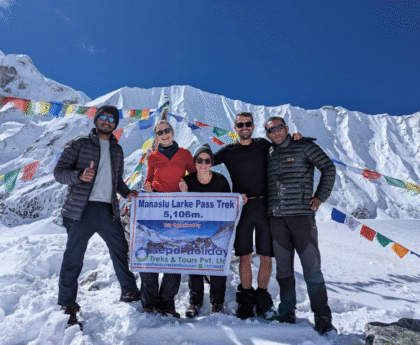The Manaslu Circuit Trek offers one of Nepal’s most spectacular and challenging trekking experiences, circumnavigating the majestic Manaslu massif, the world’s eighth-highest mountain at 8,163 meters. This remote and pristine trek combines dramatic mountain scenery, rich cultural diversity, and authentic wilderness experiences, making it an increasingly popular alternative to the more crowded Annapurna and Everest regions.
The Magnificence of Manaslu Region
The Manaslu Circuit Trek traverses through the Manaslu Conservation Area, a protected region that encompasses diverse ecosystems ranging from subtropical forests to high-altitude alpine terrain. The trek’s centerpiece, Mount Manaslu, dominates the landscape with its imposing presence, while surrounding peaks including Himalchuli, Ngadi Chuli, and Peak 29 create a stunning amphitheater of snow-capped summits.
This region remained restricted to foreign trekkers until 1991, helping preserve its pristine natural environment and authentic cultural heritage. The Manaslu Circuit Trek now provides access to this remarkable area while maintaining sustainable tourism practices that benefit local communities and protect the fragile Himalayan ecosystem.
The trek’s isolation has preserved traditional mountain cultures, particularly the Tibetan Buddhist communities in the upper valleys. Villages along the route showcase centuries-old monasteries, prayer wheels, and mani walls that reflect the deep spiritual connection between the local people and their mountain environment.
Cultural Diversity and Ethnic Heritage
One of the most compelling aspects of the Manaslu Circuit Trek is the incredible cultural diversity encountered along the route. The lower elevations are inhabited by Hindu communities practicing traditional agriculture, while the upper regions are home to Tibetan Buddhist populations who migrated from Tibet centuries ago.
The village of Samagaon serves as a cultural highlight of the Manaslu Circuit Trek, featuring traditional Tibetan architecture, ancient monasteries, and stunning views of Manaslu’s north face. Local residents maintain traditional lifestyles centered around yak herding, barley cultivation, and Buddhist spiritual practices. The nearby Pungyen Monastery offers insights into Tibetan Buddhism and houses ancient artifacts and religious texts.
Throughout the trek, visitors encounter diverse ethnic groups including Gurungs, Tamangs, and Bhotes, each contributing unique traditions, languages, and customs to the region’s rich cultural tapestry. Traditional festivals, local handicrafts, and authentic cuisine provide immersive cultural experiences that complement the trek’s natural wonders.
Trekking Route and Key Highlights
The Manaslu Circuit Trek typically requires 14-18 days, depending on the chosen itinerary and acclimatization schedule. The journey begins in Soti Khola or Machha Khola, accessible by road from Kathmandu, and follows the Budhi Gandaki River valley through increasingly remote terrain.
Lower Section (Days 1-5): The initial days of the Manaslu Circuit Trek involve trekking through lush forests, terraced farmlands, and traditional villages. Highlights include crossing numerous suspension bridges, witnessing spectacular waterfalls, and experiencing the gradual transition from subtropical to temperate vegetation zones.
Middle Section (Days 6-10): As altitude increases, the landscape transforms dramatically. Trekkers pass through Namrung, where Tibetan culture becomes more prominent, and reach Samagaon, a traditional village offering excellent acclimatization opportunities and cultural exploration. The trek to Manaslu Base Camp provides stunning close-up views of the mountain’s glaciated north face.
Upper Section (Days 11-14): The trek’s climax involves crossing Larke La Pass at 5,106 meters, one of the most challenging yet rewarding aspects of the Manaslu Circuit Trek. The pass offers panoramic views of multiple 8,000-meter peaks and marks the transition into the Marsyangdi valley, eventually connecting with the popular Annapurna Circuit route.
Descent and Completion: The final days involve descending through different terrain and climate zones, passing through villages like Dharapani and Tal before reaching the trek’s endpoint at Besisahar or continuing to other destinations.
Physical Challenges and Technical Considerations
The Manaslu Circuit Trek presents significant physical and technical challenges that require proper preparation and experience. The high-altitude crossing of Larke La Pass demands excellent physical fitness, proper acclimatization, and favorable weather conditions. Altitude-related issues are common concerns, making gradual ascent and rest days essential for successful completion.
Weather conditions can change rapidly in the Manaslu region, with afternoon snow and strong winds being common at higher elevations. The trek involves long days of walking across varied terrain, including rocky paths, glacial moraines, and steep ascents and descents. River crossings and landslide-prone sections add additional technical challenges, particularly during monsoon season.
Proper gear selection is crucial for the Manaslu Circuit Trek, with requirements including four-season sleeping bags, high-altitude clothing systems, sturdy trekking boots, and reliable navigation equipment. Many trekkers choose to hire local guides and porters, both for safety reasons and to support local communities.
Permits and Regulations
The Manaslu Circuit Trek requires multiple permits due to its location within both restricted and conservation areas. Trekkers must obtain a Manaslu Restricted Area Permit, Manaslu Conservation Area Permit, and Annapurna Conservation Area Permit. The restricted area permit requires a minimum group size of two people and a licensed guide, contributing to conservation efforts while ensuring trekker safety.
These permit requirements help manage visitor numbers and generate revenue for conservation programs and community development projects. The fees support trail maintenance, wildlife protection, and local infrastructure improvements that benefit both trekkers and resident communities.
Best Seasons and Timing
The optimal seasons for the Manaslu Circuit Trek are spring (March to May) and autumn (September to November), when weather conditions are most stable and mountain views are clearest. Spring offers blooming rhododendrons and warmer temperatures, while autumn provides crystal-clear mountain views and stable weather patterns.
Winter trekking is possible but requires extensive cold-weather preparation and experience with challenging conditions. Monsoon season (June to August) presents significant risks due to landslides, river flooding, and poor visibility, making it unsuitable for most trekkers.
Accommodation and Logistics
Accommodation along the Manaslu Circuit Trek consists primarily of basic tea houses and lodges, with comfort levels varying significantly depending on location and altitude. Lower elevation villages offer relatively comfortable facilities, while higher camps provide basic shelter with limited amenities.
Meals typically feature traditional Nepali cuisine including dal bhat, momos, and noodle dishes, with menu variety decreasing at higher altitudes. Trekkers should prepare for basic facilities and carry essential supplies including water purification tablets, energy foods, and personal medications.
Environmental Conservation and Sustainable Tourism
The Manaslu Circuit Trek operates within a fragile high-altitude ecosystem that requires careful conservation management. The Manaslu Conservation Area Project works to balance tourism development with environmental protection, implementing programs that support biodiversity conservation while providing sustainable income opportunities for local communities.
Responsible trekking practices are essential for preserving the region’s natural beauty and cultural heritage. This includes following Leave No Trace principles, respecting local customs and traditions, and supporting community-based tourism initiatives that directly benefit residents.
Conclusion
The Manaslu Circuit Trek represents one of Nepal’s premier high-altitude adventures, offering an exceptional combination of natural beauty, cultural richness, and physical challenge. This remarkable journey around the world’s eighth-highest peak provides an authentic Himalayan experience that rivals more famous trekking routes while maintaining the pristine character that makes it truly special.
For experienced trekkers seeking adventure beyond the crowded trails of Everest and Annapurna, the Manaslu Circuit Trek delivers an unforgettable experience that showcases the raw beauty and cultural depth of the Nepal Himalayas. The trek’s demanding nature, combined with its spectacular scenery and authentic cultural encounters, creates memories that last a lifetime while supporting the conservation of one of the world’s most remarkable mountain regions.





